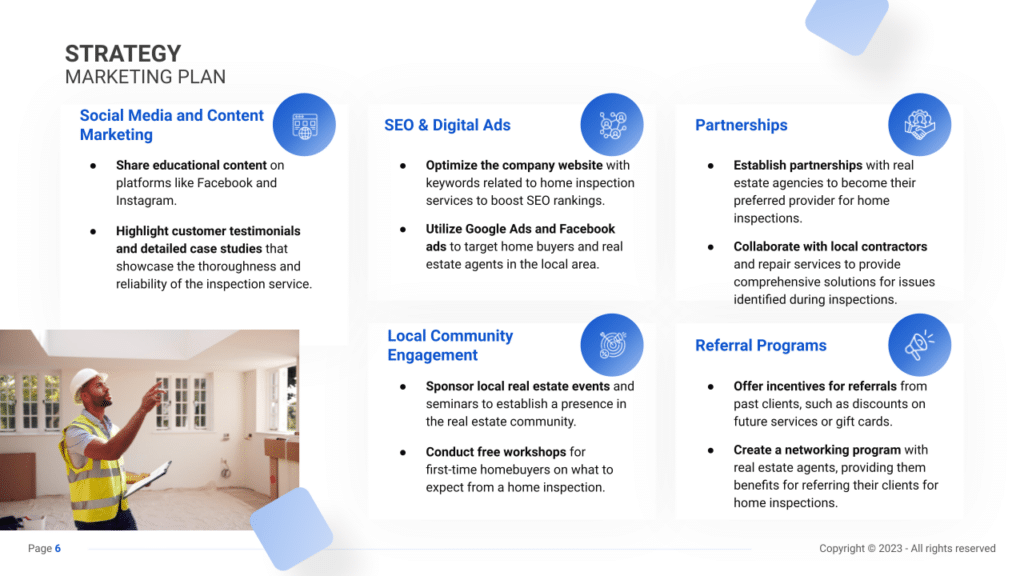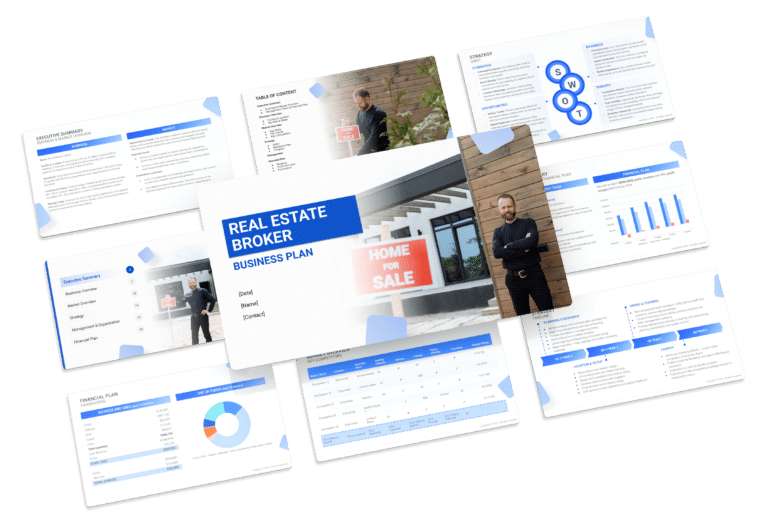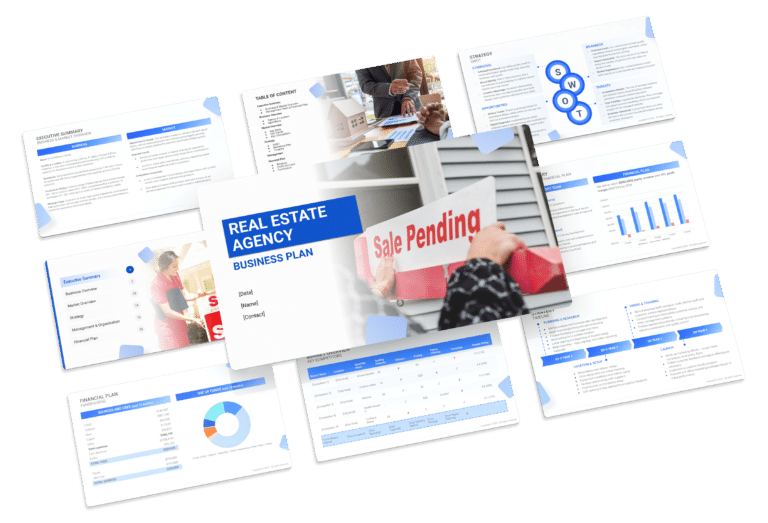Home Inspection Business Plan Template & PDF Example

Creating a comprehensive business plan is crucial for launching and running a successful home inspection business. This plan serves as your roadmap, detailing your vision, operational strategies, and financial plan. It helps establish your home inspection business’s identity, navigate the competitive market, and secure funding for growth.
This article not only breaks down the critical components of a home inspection business plan, but also provides an example of a business plan to help you craft your own.
Whether you’re an experienced entrepreneur or new to the real estate industry, this guide, complete with a business plan example, lays the groundwork for turning your home inspection business concept into reality. Let’s dive in!
The Plan
Our home inspection business plan is structured to cover all essential aspects needed for a comprehensive strategy. It outlines the business’s operations, marketing strategy, market environment, competitors, management team, and financial forecasts.
- Executive Summary: Offers an overview of your home inspection business’s concept, market analysis, management, and financial strategy.
- Business Overview: Provides detailed information on what your home inspection business offers and its operational model:
- Services & Prices: Lists the services provided by your home inspection business, including types of inspections and pricing structure.
- Market Overview: Examines the home inspection industry landscape, identifying competitors and how your business stands out:
- Key Stats: Shares industry size, growth trends, and relevant statistics for the home inspection market.
- Key Trends: Highlights recent trends affecting the home inspection sector.
- Key Competitors: Analyzes main competitors nearby and how your business differs from them.
- Strategy: Outlines how the home inspection business intends to achieve growth and attract clients:
- SWOT: Strengths, weaknesses, opportunities, and threats analysis.
- Marketing Plan: Strategies for attracting and retaining customers.
- Timeline: Key milestones and objectives from start-up through the first year of operation.
- Management: Information on who manages the home inspection business and their roles.
- Financial Plan: Projects the business’s 5-year financial performance, including revenue, profits, and expected expenses.

Executive Summary
The Executive Summary introduces your home inspection business plan, offering a concise overview of your services. It should detail your market positioning, the range of home inspection services you offer, its location, size, and an outline of day-to-day operations.
This section should also explore how your home inspection business will integrate into the local market, including the number of direct competitors within the area, identifying who they are, along with your business’s unique selling points that differentiate it from these competitors.
Furthermore, you should include information about the management and co-founding team, detailing their roles and contributions to the business’s success. Additionally, a summary of your financial projections, including revenue and profits over the next five years, should be presented here to provide a clear picture of your home inspection business’s financial plan.
Business Overview
For a home inspection, the Business Overview section can be concisely divided into 1 main slide:
Inspection Services & Pricing
Detail the range of home inspection services offered, from basic structural inspections to specialized services like mold inspection, radon testing, or energy audits. Outline your pricing strategy, ensuring it reflects the quality of services provided and matches the market you’re targeting. Highlight any packages, pre-purchase deals, or annual inspection programs that provide added value to your clients, encouraging repeat business and customer loyalty.
Market Overview

Industry Size & Growth
In the Market Overview of your home inspection business plan, start by examining the size of the home inspection industry and its growth potential. This analysis is crucial for understanding the market’s scope and identifying expansion opportunities.
Key Market Trends
Proceed to discuss recent market trends, such as the increasing consumer awareness of the importance of home inspections, the growth in real estate transactions, and the demand for specialized inspection services. For example, highlight the need for services like energy efficiency assessments, mold inspections, and radon testing, alongside the rising importance of digital reporting and customer-friendly technology in inspections.
Competitive Landscape
A competitive analysis is not just a tool for gauging the position of your home inspection service in the market and its key competitors; it’s also a fundamental component of your business plan.
This analysis helps in identifying your home inspection service’s unique selling points, essential for differentiating your business in a competitive market.
In addition, the competitive analysis is integral in laying a solid foundation for your business plan. By examining various operational aspects of your competitors, you gain valuable information that ensures your business plan is robust, informed, and tailored to succeed in the current market environment.
Identifying Your Competitors in the Home Inspection Industry
The first step in conducting a competitive analysis is to identify your competitors. Begin by listing local home inspection services. If your business specializes in eco-friendly or energy-efficient home inspections, your direct competitors include nearby firms that offer similar services, as well as larger companies that might provide a broad range of inspection services. Additionally, consider indirect competitors like real estate agencies that offer pre-sale inspection services.
Utilize online tools such as Google Maps to determine the geographical spread of these competitors. Platforms like Yelp and other customer review sites can offer insights into the strengths and weaknesses of these competitors through customer reviews. For example, if a competitor is frequently lauded for its thoroughness and quick report turnaround, these are significant competitive strengths.

Home Inspection Competitors’ Strategies
Analyzing the strategies of these competitors involves several key areas:
- Service Offerings: Examine the scope of services provided. If “Detailed Home Inspectors” is popular for comprehensive checks that include pest and mold inspection, it indicates a market demand for in-depth analysis.
- Certifications and Expertise: Consider the certifications and expertise touted by competitors. A company like “Certified Inspectors Group” that employs inspectors with advanced credentials might attract customers looking for high levels of professionalism and accuracy.
- Pricing Strategy: Compare your pricing with that of competitors. Are your inspection fees competitive with budget-friendly services like “Budget Inspect,” or are they aligned with more premium offerings at “Elite Home Inspections”?
- Marketing Tactics: Look at how competitors promote their services. Do they utilize online advertising, participate in local home shows, or forge partnerships with real estate firms?
- Customer Service: Evaluate the quality of customer interaction and follow-up. For instance, “Friendly Inspect Service” might be known for its approachable inspectors and helpful customer support, enhancing the overall service experience.
- Operational Efficiency: Observe if competitors use technology or innovative processes to enhance their services, such as “Efficient Inspections” with its online scheduling and digital report delivery.
What’s Your Home Inspection Business’s Value Proposition?
Reflect on what makes your home inspection service unique. Perhaps you provide detailed thermal imaging reports, or maybe you specialize in historic homes and have expertise that others in your area lack.
Identify market gaps through customer feedback and industry trends, such as an increasing demand for energy efficiency audits, which could represent a market niche if not widely covered by competitors.
Consider your location: A home inspection business in a rapidly growing housing market might focus on pre-purchase inspections for new homeowners, whereas one in an area with older housing stock might specialize in pre-renovation inspections or problem detection for long-term maintenance.
Strategy

SWOT
First, conduct a SWOT analysis for the home inspection business, highlighting Strengths (such as experienced inspectors and advanced technology), Weaknesses (including high operational costs or limited brand recognition), Opportunities (for example, increasing awareness of home inspections and expanding real estate market), and Threats (such as economic downturns that may decrease real estate transactions).

Marketing Plan
Next, develop a marketing strategy that outlines how to attract and retain clients through targeted advertising, promotional discounts, engaging social media presence, and community involvement.
Marketing Channels
Explore diverse marketing channels to enhance brand visibility and attract potential clients to your home inspection services.
Digital Marketing
- Website and SEO: Your website serves as the virtual storefront of your business. Create a professional and user-friendly website that showcases your expertise, sample inspection reports, client testimonials, and educational resources. Optimize it for local SEO to rank higher in search engine results.
- Content Marketing: Content marketing is an excellent way to establish authority in the field. Start a blog addressing common concerns, offering maintenance tips, and providing insights into property evaluation. This content not only educates your audience but also attracts organic traffic to your website.
- Social Media Presence: Leverage social media platforms like LinkedIn and Facebook to engage with potential clients and industry professionals. Share informative content, success stories, and updates about your services. Engage with followers through Q&A sessions, polls, and live sessions to foster a sense of community and trust.
Local Advertising
- Networking: Network with real estate agents, property managers, and local contractors. Personal connections can often lead to referrals and partnerships, significantly boosting your clientele.
- Partnerships and Referral Programs: Partner with real estate agencies or mortgage brokers to offer discounted inspection rates for their clients. Implement a referral program rewarding both referrers and referees.

Sales Channels
Implement effective sales tactics to convert leads into loyal customers and increase revenue streams.
In-Person Consultations
Maximize value during property inspections:
- Comprehensive Services: Offer additional services tailored to specific client needs during the inspection. This could include specialized testing, environmental assessments, or consultations on home maintenance practices. Customize service packages to accommodate diverse client requirements.
- Detailed Reports: Provide comprehensive and easily understandable inspection reports. Highlight essential findings, recommend necessary repairs or improvements, and offer guidance for ongoing property maintenance. Include visual aids, such as images or videos, for better comprehension.
Consultative Selling
- Offer Free Consultations: Offering free consultations or webinars is an excellent way to showcase your expertise and build rapport with potential clients. These sessions can educate homeowners and buyers on the significance of thorough inspections, fostering trust in your services.
- Customized Reports: Customizing inspection reports to address specific client concerns and highlighting crucial findings with actionable recommendations demonstrates your commitment to providing value beyond the inspection itself.
Package Deals and Add-On Services
- Package Deals: Offer bundled services like home maintenance guides or follow-up inspections at reduced rates for returning customers.
- Service Add-Ons: Introduce add-on services such as environmental assessments or specialized testing for an additional fee.
Membership and Loyalty Programs
- Subscription-Based Services: Develop subscription-based membership options offering periodic inspections or consultations at a discounted rate.
- Loyalty Rewards System: Establish a digital loyalty program where clients earn points for every service booked or referred customer.
- Personalized Follow-ups: Implement a personalized follow-up system post-inspection. Offer ongoing support and advice, reminding clients of upcoming inspections or property maintenance tasks.
Strategy Timeline
Finally, create a detailed timeline that outlines critical milestones for the home inspection business’s launch, marketing efforts, client base growth, and expansion objectives, ensuring the business moves forward with clear direction and purpose.

Management
The Management section focuses on the home inspection business’s management and their direct roles in daily operations and strategic direction. This part is crucial for understanding who is responsible for making key decisions and driving the home inspection business toward its financial and operational goals.
For your home inspection business plan, list the core team members, their specific responsibilities, and how their expertise supports the business.


Financial Plan
The Financial Plan section is a comprehensive analysis of your financial projections for revenue, expenses, and profitability. It lays out your home inspection business’s approach to securing funding, managing cash flow, and achieving breakeven.
This section typically includes detailed forecasts for the first 5 years of operation, highlighting expected revenue, operating costs and capital expenditures.
For your home inspection business plan, provide a snapshot of your financial statement (profit and loss, balance sheet, cash flow statement), as well as your key assumptions (e.g. number of customers and prices, expenses, etc.).
Make sure to cover here
_ Profit and Loss
_ Cash Flow Statement
_ Balance Sheet
_ Use of Funds









